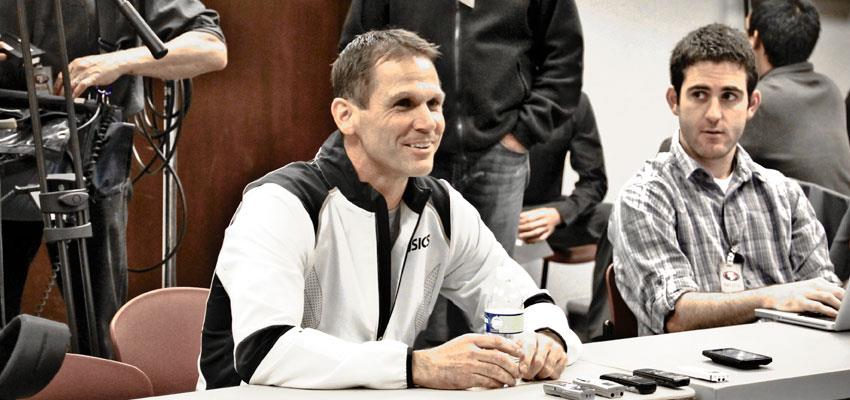
On Wednesday, safety Jamal Adams flew up mock draft boards after he clocked a 4.33 40-yard-dash time at his LSU Pro Day. As ESPN’s Mike Triplett pointed out, Adams is now in the top-5 pick discussion, which is mostly uncharted territory for a present-day safety.
“Hopefully I make history,” Adams said Wednesday. “Sean Taylor and Eric Berry were the highest safeties to ever go at number five, so hopefully I go number four. We’ll see.” Adams is only partially correct. The late great Eric Turner was selected with the second pick of the 1991 NFL Draft; four years before Adams was even born. But even Cicero (in my head, he’d be a Sunday Ticket subscriber) would recognize Adams has a chance to make history on April 27th.
With the 49ers’ plan to move to a Pete Carroll-style 4-3 Cover-3 defense, they are once again in the market for a new safety. After the LSU Pro Day news, the Sacramento Bee’s Matt Barrows was one of the first to propose a potential marriage between Adams and the 49ers, who currently hold the second overall selection in the upcoming 2017 NFL Draft.
Have to think Adams is a possibility to #49ers at pick No. 2. https://t.co/uvYnKJSgpq
This sparked a debate between the two of us, and then some further thinking by me. Another early-round safety? Weren’t the Baalke-led Niners always one of the first teams to pull a safety off the board? A little bit of research confirmed it.
Dug into the numbers - last 4 years, what team spent the most draft capital at the safety position? #49ers, and it's not even close. https://t.co/DrsSFaPioG
Further research revealed a number of interesting facts. Trent Baalke ran a total of seven drafts for the 49ers, from 2010 to 2016. In the first two rounds of these Baalke drafts, the 49ers selected four safeties: Jaquiski Tartt, Jimmie Ward (S, converted to CB, and maybe back to S), Eric Reid, and Taylor Mays. How did Baalke compare to his counterparts in the rest of the league? Only two other teams drafted two safeties in the first two rounds, and the rest drafted either one or zero. Of the four early-round safeties Baalke drafted, he selected two in the first round. During the same time period, only nine other teams drafted a safety in the first round.
The numbers are surely striking, and even more so when you consider the draft capital used on these early picks. To delve into this further, we will use Jimmy Johnson’s draft value chart, which is still the most commonly used standard for draft pick valuation.
By using this chart to assign a value to each of Baalke’s aftaft selections, we can determine where Baalke spent his draft capital compared to other teams, and where he overspent and underspent on various positions.
Baalke spent a total of 2404.8 “points” on safeties, which was by far the most in the league. Only three teams spent half the draft capital the 49ers used at the position. Baalke outspent the remaining teams by factors of two to 96, including the Seattle Seahawks, who drafted both Earl Thomas and Kam Chancellor at under half the cost of Baalke’s selections.
Every team’s draft capital is limited, so when a team chooses to overspend at certain positions, they choose to ignore other positions. Baalke’s highest areas of spend were on the line, with over 4800 points going to defensive linemen and edge rushers, and over 3300 to offensive linemen. Next comes the safeties, at just over 2400 points. Unfortunately, at this point, Baalke nearly ran out of draft capital. The combined capital spent on every remaining position barely exceeds the amount Baalke spent on the safety position alone. It’s no wonder that these skill positions Baalke chose to ignore are the same positions-of-need for the 49ers today.
If the overdrafting of one position was indeed a strategy, then Baalke picked the wrong position. The current CBA’s limitations on rookie salaries incentivizes teams to draft players who play expensive positions. Safeties are usually among the cheapest players on the field, and are relatively easy to replace via free agency. No one should know this better than Baalke, as the 49ers started free agent strong safeties every year Baalke was with the team.
It is easy to point out Baalke’s flaws as a GM, from his holes in talent evaluation, to his rocky relationship with Jim Harbaugh, to his lack of spending in free agency. But there were also good times – the draft-day trades, the Championship runs, the one-4th-down-pass away from glory. One has to wonder if things would have ended differently if Baalke spent his draft capital a bit more intelligently. But one thing, we do know. Out there somewhere tonight, Baalke will be wearing a suit, and will close his eyes as he drifts off to sleep. And he will sleep soundly, because although he was fired, at least he was replaced by his one true love.
A safety.

